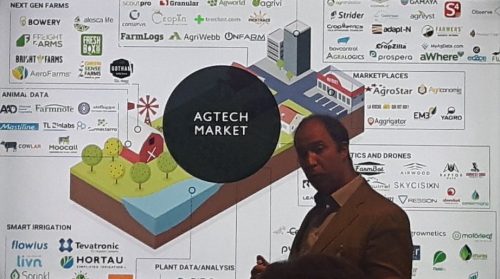
From the mid-17th century to the end of the 19th century, Britain’s farming industry was utterly transformed.
Now referred to as the British Agricultural Revolution, the period saw a combination of advances in technology, policy, transport infrastructure, and land use that would change the face of farming forever.
Today, I believe we’re on the cusp of another such revolution.
The idea of a fourth industrial revolution – “characterized by a fusion of technologies that is blurring the lines between the physical, digital, and biological spheres” – has been around for a few years now. Its definition is broad enough to encompass farming, but I would argue that the possibilities for farming justify their own category.
As much as 72% of land in the UK is used for agriculture, and, as well as producing the food we eat, farming contributes heavily to the £111 billion GVA of the agri-food sector.
And momentum in the sector now feels to be reaching a critical point.
Feeding the future
Recently, IDEALondon played host to a collaborative event run by University College London, Cisco, and Rothamsted Research, one of the oldest agricultural research institutions in the world.
On the agenda? Feeding the future.
Dr. Riaz Bhunno, who serves as director of the Global Food Security Programme, emphasised the need for a food system that incorporates health, sustainability, and resilience.
Consumers, he said, increasingly hold the power when it comes to shaping our global food system.
A growing population, diets that shift with changes in income, the impact of livestock as consumers – these are all factors that put huge pressure on food production. And if we don’t consider more resilient, sustainable ways to either curb or meet demand then the environmental and human impacts could be devastating.
But this comes with its own challenges too, of course, Karp explained.
How can we mitigate the impact of failure in invention, for instance? And, more generally, is it possible to balance a push to more automated and technology-led farming processes with societal acceptance?
Rocky ground

The one thing that’s certain in agriculture, said impact investor Paul Rous, is uncertainty
Farming innovations are traditionally incremental, he argued, and either shifting or accommodating farmers’ existing mindsets will be key if pro
gress is to be made in the space.
Organisations wanting to contribute to the future of agr iculture will need to work to secure the trust of those people ultimately responsible for farming the land.
Brexit, meanwhile, has done much to exacerbate this uncertainty – with stalled talks leaving questions marks around issues such as livestock transportation and subsidy allocation.
So how do you garner investment into such projects? Or rather, how do you prove the worth of these investments?
Cisco’s head of co-innovation, Peter Shearman, described how projects such as 5G RuralFirst aim to make the business case for agritech innovations.
Based across three test beds – in Somerset, Shropshire, and the Orkney Islands respectively – the 5G RuralFirst project is purposefully focused on rural and remote areas. It aims to demonstrate the huge potential for industries such as agriculture and tourism in these places.
Incorporating new automated dairy farm solutions, self-driving tractors, drone-based observation and more, the project is as much about showing what’s technically possible as it is about demonstrating the huge untapped business potential.
Making connections
As ever, connectivity has a huge role to play here.
Whether for sensor-laden salmon farms or HD video feeds being beamed down from remote control drones, quick and consistent upload and download speeds are essential.
In this, there’s a huge opportunity for Cisco to collaborate with parties from across agriculture, academia and government.
Paul Rous, in particular, was keen to emphasise the need to build better relationships between the various players in this burgeoning market, and the event’s organiser – UCL’s Dr. Eugenio Zapatas-Solvas – pointed to joint funding bids as an example of how this can work.
Consortium-led projects like 5G RuralFirst are where I believe progress will be made in this regard: serving not only to produce world-first innovations, but also strengthening collaborative relationships between key players in the space.
1 Comments
Great blog! We live in a wacky world 🙂